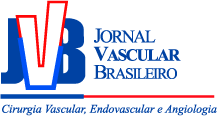Análise morfométrica da carótida de suínos submetidos a angioplastia com ou sem implante de stent de cromo-cobalto
Morphometric analysis of swine carotid artery angioplasty with or without cobalt-chromium stent implantation
João Luiz de Lara Elesbão; Adamastor Humberto Pereira; Marco Aurélio Grüdtner; Fabiola Meyer
Resumo
Palavras-chave
Abstract
Keywords
References
Fattori R, Piva T. Drug-eluting stents in vascular intervention. Lancet. 2003;361:247-9.
Inoue S, Koyama H, Miyata T, Shigematsu H. Pathogenetic heterogeneity of in-stent lesion formation in human peripheral arterial disease. J Vasc Surg. 2002;35:820-2.
Fischer A, Wienecke H, Brauer H, Erbel R. Metallic biomaterials for coronary stents. Z Kardiol. 2001;90:251-62.
Hansi C, Arab A, Rzany A, Ahrens I, Bode C, Hehrlein C. Differences of platelet adhesion and thrombus activation on amorphous silicon carbide, magnesium alloy, stainless steel, and cobalt chromium stent surfaces. Catheter Cardiovasc Interv. 2009;73:488-96.
Waksman R, Pakala R, Kuchulakanti PK. Safety and efficacy of bioabsorbable magnesium stents in porcine coronary arteries. Catheter Cardiovasc Interv. 2006;68:607-17.
Messer RL, Wataha JC, Lewis JB, Lockwood PE, Caughman GB, Tseng WY. Effect of vascular stent alloys on expression of cellular adhesion molecules by endothelial cells. J Long Term Eff Med Implants. 2005;15:39-47.
Gotman I. Characteristics of metals used in implants. J Endourol. 1997;11:383-9.
Koch W, Tiroch K, von Beckerath N, Schömig A, Kastrati A. Tumor necrosis factor-alpha, lymphotoxin-alpha, and interleukin-10 gene polymorphisms and restenosis after coronary artery stenting. Cytokine. 2003;24:161-71.
Versaci F, Gaspardone A. Prevention of restenosis after stenting: the emerging role of inflammation. Coron Artery Dis. 2004;15:307-11.
Welt FG, Rogers C. Inflammation and restenosis in the stent era. Arterioscler Thromb Vasc Biol. 2002;22:1769-76.
Ouriel K. Peripheral arterial disease. Lancet. 2001;358:1257-64.
Toutouzas K, Colombo A, Stefanadis C. Inflammation and restenosis after percutaneous coronary interventions. Eur Heart J. 2004;25:1679-87.
Cwikiel W, Harnek J, Zoucas E, Stenram U. Proliferative response in smooth muscle cells after angioplasty or insertion of self-expanding stents: An experimental study in pigs. Acta Radiol. 1997;38:124-8.
De Meyer GR, Bult H. Mechanisms of neointima formation: lessons from experimental models. Vasc Med. 1997;2:179-89.
Wolf YG, Gertz SD, Banai S. Animal models in syndromes of accelerated arteriosclerosis. Ann Vasc Surg. 1999;13:328-38.
Narayanaswany M, Wright K, Kandarpa K. Animal models for atherosclerosis, restenosis, and endovascular graft research. J Vasc Interv Radiol. 2000;11:5-17.
Tsai S, Butler J, Rafii S, Liu B, Kent KC. The role of progenitor cells in the development of intimal hyperplasia. J Vasc Surg. 2009;49:502-10.
Shi ZS, Feng L, He X. Vulnerable plaque in a Swine model of carotid atherosclerosis. AJNR Am J Neuroradiol. 2009;30:469-72.
França LH, Pereira AH, Perini SC. Self-expandable nitinol stent placement in homocysteinemic porcine aorta. Clinics. 2008;63:229-36.
Verheye S, Salame MY, Robinson KA. Short- and long-term histopathologic evaluation of stenting using a self-expanding nitinol stent in pig carotid and iliac arteries. Catheter Cardiovasc Interv. 1999;48:488-96.
Pasa MB, Pereira AH, Castro Junior C. Morphometric analysis of intimal thickening secondary to stent placement in pig carotid arteries. Acta Cir Bras. 2008;23:165-72.
Grudtner MA, Pereira AH, Costa LF, Souza GG, Argenta R, Longhi JA. Efeitos a curto prazo de stents não recobertos e recobertos com politetrafluoroetileno em aorta de suínos: um modelo experimental. Acta Cir Bras. 2004;19:120-5.
Dutra CF, Pereira AH. Digital morphometric analysis of the aortic wall in pigs following implantation of dacron-covered stents versus non-covered stents. Acta Cir Bras. 2004;19:210-219.
Castro Junior C, Pereira AH, Pasa MB. Morphometric analisis of intimal reaction after stent implantation in iliac arteries submitted to angioplasty in pigs. Acta Cir Bras. 2006;21:139-43.
Stampfl U, Sommer CM, Thierjung H. Reduction of late in-stent stenosis in a porcine coronary artery model by cobalt chromium stents with a nanocoat os polyphosphazene (Polyzene-F). Cardiovasc Intervent Radiol. 2008;31:1184-92.
Kereiakes DJ, Cox DA, Hermiller JB. Usefulness of a cobalt chromium coronary stent alloy. Am J Cardiol. 2003;92:463-6.
Santos MB. Ergonomia, carga mental de trabalho, riscos e prevenção de acidentes: o caso do trabalhador em histotécnica. 2007.



